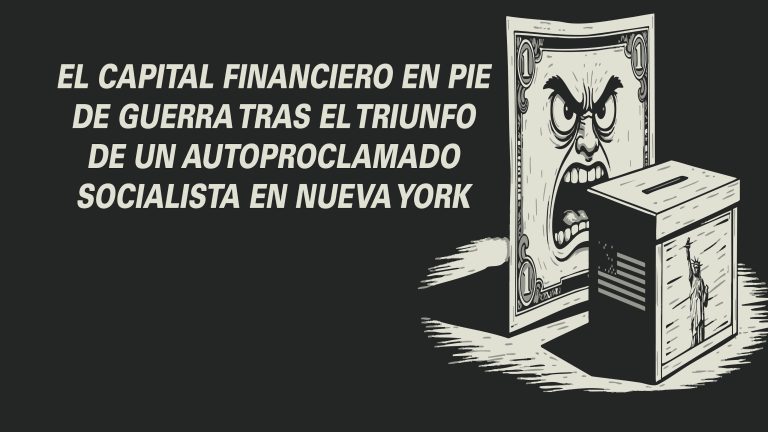Julian NH
The recent political campaigns in the United States, aimed at the election of the Democratic Party candidate who will face Donald Trump in the presidential elections in November of this year, will have once again shown that the majority of young people in this country are already tired of the neoliberal capitalist model. Still suffering the consequences of the 2008 financial crisis, one in which the largest banks and financial centers were protagonists, using people’s savings to fuel a real estate bubble within the country that burst to the surprise of orthodox economists, causing a global recession of a magnitude not seen since the Great Depression; people are now in an era that no longer appears to be conducive to economic growth as strong as in the past, a growth that although always had uneven benefits, the wealthy capturing the majority, at least kept alive the hope of the American dream, this ideal of social mobility that accordingly leads a poor person to become rich by means of their own personal effort. But this speech has lost its legitimacy more than in other times, and the appearance of a presidential candidate who calls himself a democratic socialist has broken with all conceptions of the average American.
Socialism has become fashionable among the youth of the United States thanks to Bernie Sanders and some of his comrades, considered part of what has been baptized as “The Squad”, with representatives such as Ilhan Omar, Alexandria Ocasio-Cortez and Rashida Tlaib, the latter two being members of the country’s largest socialist organization, the Democratic Socialists of America (DSA). The generation gap has been seen again and again in the elections for the Democratic Party presidential candidate, which Bernie Sanders has tried to win in an attempt to enter the party generally considered to be on the left of the Republican Party. This gap is evident in the fact that the majority of young people have voted for the socialist candidate, while the oldest, over 40 years old, have been more conservative in their ideals, but even in this age range, socialism has also won over part of the population.
Although Bernie Sanders proclaims himself to be a democratic socialist, he is actually more of a social democrat, but for the right-wing political environment (neoliberal, neoconservative, or bourgeois nationalist) that has almost always reigned in the country, it is truly a radical break with traditional politics. It has shaken the powerful and it is coming at an opportune moment in the history of the United States, one after the Cold War, when there is no longer an external enemy to blame for the socialist sympathies of the people. Bernie Sanders distinguishes himself from others by being the only candidate who does not depend on money donated by the elites to carry out his political campaign. Most of the contributions to his campaign come from the people, including the Latino community which is one of the most fervent in its support for the candidate. Furthermore, his campaign has focused on mobilizing the masses, with an emphasis on the unions, and he has repeatedly reiterated the idea of a political revolution (not as extensive as a socialist revolution, but worth doing). In fact, if he becomes president, due to the reluctance of the congress and the supreme court to collaborate with his “radical” proposals, he will depend on the mobilization of the people to fulfill them, and in view of this eventual scenario, there is nothing to prevent the masses from going for more and finally seize power in one of the wealthiest countries in the world.
Among the proposals launched by Bernie Sanders, there is an implementation of a complete transition to green energy by 2030[1], employing thousands of state-contracted workers and concentrating on the most marginalized locations in the country, assuring workers in the industry of fossil fuels employment, and severely punishing that industry for its inaction and its sabotage of the measures that have been previously implemented to combat climate change. It should be said that it falls short of proclaiming a nationalization of the energy industry, one that has been dominated for decades by the most powerful and voracious transnational corporations in the world. On the other hand, Sanders offers a universal health coverage plan, something that in a country with a fully privatized health industry would be a relief for the poorest, although it does not propose nationalizing hospitals, or pharmaceutical companies, for example. He offers to make tuition-free all of the public universities in the country and eliminate the debt that most students must incur to pay for their studies. He proposes to increase the number of unionized workers in all industries and for workers to have more power in managerial decisions. Sanders supports a plan to build social housing, which in the United States is almost non-existent and its lack has caused the growth of a large homeless population. He has also proposed to reform the country’s prison system, which operates for profit and particularly affects minorities; ending mass deportations, etc. And how does he plan for the government to pay all of this? Raising taxes on the richest, taxing stock transactions on Wall Street, cutting the budget for military operations. It is noteworthy that he wants to reform the foreign policy of the United States, and has repeatedly come out to denounce cases such as the recent coup d’état in Bolivia (2019), and has refused to recognize Juan Guaidó as president of Venezuela, for example, but it does not appear he will end the imperialist role of the United States once and for all.
In 2016 it was the first attempt by Bernie Sanders to obtain the Democratic Party candidacy, and in early 2020 he is still in the process of his second attempt, but unfortunately, and perhaps even predictably, he has already lost in both cases. This does not mean that he has not been close to winning, its just that on this last occasion it has been needed the joint action of the entire elite of the Democratic Party to be able to defeat the popular Bernie Sanders, sometimes even committing acts that makes one suspect of fraud. Particularly, in the state of Iowa, in the first state elections to choose the presidential candidate representing the Democratic Party, the digital system that would supposedly help in the counting of votes failed. That app used would later be found to have been funded by candidates opposite to Bernie Sanders, though no more has been said or done. In that election, Sanders and an elite candidate, Pete Buttigieg, were nearly tied, although the popular vote was won by Sanders. And it is this the other problem of elections in the United States, where both the presidential and the internal party elections are not democratic, since the popular vote is not the one that wins. What is voted for is special “electors” whose number depend on the region where one is, but it is not proportional to the number of inhabitants and favors low rural populations; these electors subsequently have the task of voting for the candidate for whom they were voted, but if that candidate gives up, they have the freedom to choose another, and even if the original candidate did not give up, in theory, they could also choose another candidate.
Now, in the current elections there were at least 6 candidates at the beginning, the majority being the same bourgeois as always: Bernie Sanders initially won New Hampshire and Nevada, but lost to Joe Biden in South Carolina, a candidate with the same kind of proposals as Hillary Clinton (the neoliberal presidential candidate against Trump in 2016), a candidate who would be given the whole support of the elite in the party at that moment, closing ranks immediately, forcing the other remaining candidates to give up and support Biden. In the elections for the states that followed, the results of this strategy came to light, and Bernie Sanders lost most of the elections, but at least won in one of the most important states in the United States, California. As an interesting note, a candidate who had tried to win these elections, the billionaire Michael Bloomberg, believed that he could buy the election by flooding social networks with his propaganda, without following the own rules that the Democratic Party imposes for the nominations, again demonstrating that the Democratic Party favors the elites, although he was not successful in the end.
Bernie Sanders is not the ideal candidate to bring workers to power in the United States, as he is a socialist only on paper, but we cannot deny that he is responsible for the fact that a new generation of young people has somehow been introduced to socialist ideas, and we cannot deny that his strategy of relying on the masses to pass his proposals may lead to something greater than what he plans.
The largest socialist organization in the United States, the Democratic Socialists of America, founded in 1987, is considered as democratic socialist, but in practice they have members of multiple tendencies. This organization has seen exponential growth thanks to the support it has given to Bernie Sanders, in fact, when they started with this support in 2014, they had just 6,500 members, but in the 2016 presidential elections they already had 8,500. From November 2016 to July 2017 they got 13,000 more members, and by 2018 they already had 50,000 members. Of course, this does not mean that all members are active, but at least they support the organization financially, and the important thing is that Americans are being increasingly positive about the idea of socialism. The effervescence is noticeable in the people who have begun to organize after decades of alienation, after decades of policies that have only led to more exploitation, living in a system that is not even democratic and where election after election a false choice is presented between two sides of the same coin, the Democratic Party and the Republican Party. It is now, when the global system seems to be approaching a new recession, that the organization of the masses will be important. The 2008 crisis lacked an organized response, but the people have learned, and today they are more prepared to finish with the roots of the capitalist system once and for all.


